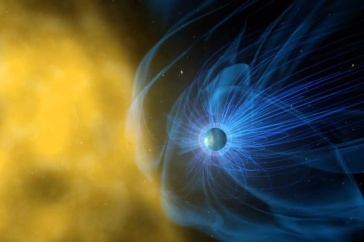
Researchers have received a grant to study geomagnetic storms on the night side of the Earth. Photo courtesy of NASA/James Spann.
Researchers from the UNH Space Science Center have received a new NASA grant to study geomagnetic storms on the night side of the Earth. By tapping into data sets not normally used for this type of research, scientists hope to get a different perspective in the pursuit of forecasting space storms that cause the Northern Lights, but can also wreak havoc on satellites and astronauts in space and cause power outages.
UNH will receive $512,000 as part of this three-year study, which will be co-led by Amy Keesee, UNH professor of physics, and Chris Mouikis, UNH research scientist. They plan to collaborate with Christine Gabrielse, a space physicist from Aerospace Corporation in El Segundo, California, and Keesee will work closely with one UNH graduate student on the project as well.
“We need to understand these geomagnetic storms better to create forecasts that can help us protect our infrastructure,” Keesee says.
The Earth’s magnetic field is strongly influenced by the sun. As the solar wind blows energetic particles out into the solar system, the Earth’s magnetosphere is stretched to form a tail on the side away from the sun — the night side. As the magnetic field lines are stretched like rubber bands, they can then reconnect and slingshot the sun’s energetic particles towards the Earth, Keesee says.
The team will comb through data from three NASA space missions — MMS, TWINS, and THEMIS — to gain a better understanding. Data from THEMIS and MMS provide high-resolution, local measurements of the ions, electrons and magnetic fields, Keesee explains, while TWINS data offers a lower-resolution global view of the ions to provide more context. Combined, these viewpoints will provide scientists with a clearer picture of what’s happening with the ions.
“I’ve been working with the TWINS data for many years and the technique I’m using focuses on the magnetotail, which is outside of the typical range that other researchers use that data for,” Keesee says.
The Institute for the Study of Earth, Oceans, and Space (EOS) is UNH's largest research enterprise, comprising six centers with a focus on interdisciplinary, high-impact research on Earth and climate systems, space science, the marine environment, seafloor mapping, and environmental acoustics. With more than $58 million in external funding secured annually, EOS fosters an intellectual and scientific environment that advances visionary scholarship and leadership in world-class research and graduate education.
-
Written By:
Rebecca Irelan | Institute for the Study of Earth, Oceans, and Space | rebecca.irelan@unh.edu | 603-862-0990

















































